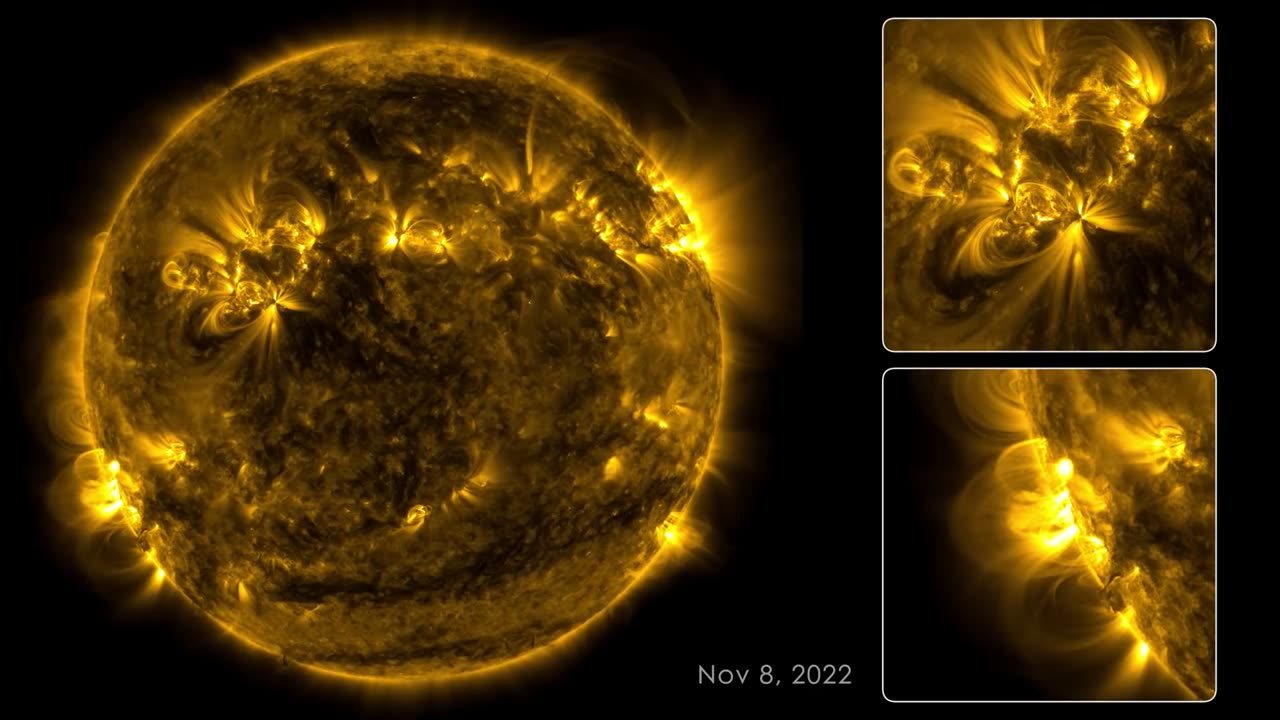Premium Only Content

133 Days on the Sun
This 133-day time lapse showcases photos taken at a wavelength of 17.1 nanometers, which is an extreme-ultraviolet wavelength that shows the Sun's outermost atmospheric layer: the corona. Compiling images taken 108 seconds apart, the movie condenses 133 days, or about four months, of solar observations into 59 minutes
This video chronicle solar Activity as captured by NASA's Solar Dynamics Observatory (SDO).
From its orbit in space around Earth, SDO has steadily imaged the sun in 4K x 4K resolution for nearly 13 years. This information has enable countless new discoveries about the working our closest star and how it influences the solar system.
With a triad of instruments, SDO captures an image of the Sun every 0.75 seconds. The Atmospheric Imaging Assembly (AIA) instrument alone captures images every 12 seconds at 10 different wavelengths of light. This 133-day time lapse showcases photos taken at a wavelength of 17.1 nanometers, which is an extreme-ultraviolet wavelength that shows the Sun’s outermost atmospheric layer: the corona. Compiling images taken 108 seconds apart, the movie condenses 133 days, or about four months, of solar observations into 59 minutes. The video shows bright active regions passing across the face of the Sun as it rotates. The Sun rotates approximately once every 27 days. The loops extending above the bright regions are magnetic fields that have trapped hot, glowing plasma. These bright regions are also the source of solar flares, which appear as bright flashes as magnetic fields snap together in a process called magnetic reconnection.
While SDO has kept an unblinking eye pointed toward the Sun, there have been a few moments it missed. Some of the dark frames in the video are caused by Earth or the Moon eclipsing SDO as they pass between the spacecraft and the Sun. Other blackouts are caused by instrumentation being down or data errors. SDO transmits 1.4 terabytes of data to the ground every day. The images where the Sun is off-center were observed when SDO was calibrating its instruments.
SDO and other NASA missions will continue to watch our Sun in the years to come, providing further insights about our place in space and information to keep our astronauts and assets safe.
The music is a continuous mix from Lars Leonhard’s “Geometric Shapes” album, courtesy of the artist.
Credit: NASA's Goddard Space Flight Center
Scott Wiessinger (PAO): Lead Producer
Tom Bridgman (SVS): Lead Visualizer
Scott Wiessinger (PAO): Editor
On the left side of the frame is the full circle of the Sun. It appears in a golden yellow color, but splotchy and with thin yellow wisps extending from the surface. Some areas are very bright and others almost black. The whole Sun rotates steadily, with one full rotation taking 12 minutes in this time lapse. There are usually only a few bright regions visible at a time and they shift and flash like small fires. From these regions there are wispy loops reaching up above the surface that rapidly change shape and size.
On the right side of the frame are two white-outlined squares with enlargements of interesting regions of the Sun.
-
 2:49:19
2:49:19
Laura Loomer
6 hours agoEP116: COUP DE SANTIS: FL Legislators Investigate Ron And Casey For Fraud
61.6K42 -
 LIVE
LIVE
SpartakusLIVE
12 hours ago$50,000 Tourney w/ ZLANER & Oak! || MORE WZ to follow
297 watching -
 1:51:14
1:51:14
FreshandFit
2 days agoUniversity Of South Carolina Speech
85.6K23 -
 2:09:39
2:09:39
RiftTV/Slightly Offensive
9 hours ago $10.20 earnedJordan Peterson EMBARRASSES Himself On Rogan with PITIFUL Rant on “Extremism” | Slightly Offensive
56.4K41 -
 14:38
14:38
Producer Michael
9 hours agoWE TRIED TO SELL OUR CARS AT CARMAX!
46.9K3 -
 5:36:05
5:36:05
a12cat34dog
8 hours agoI'VE NEVER PLAYED THIS GAME :: The Elder Scrolls IV: Oblivion Remastered :: FIRST-TIME PLAYING {18+}
26.7K7 -
 2:17:47
2:17:47
AlaskanBallistics
15 hours ago $6.36 earnedI Love this Gun Podcast #28
57.2K14 -
 3:12:28
3:12:28
tacetmort3m
13 hours ago🔴 LIVE - THIS GAME IS VERY FUN NOW - NO MORE ROOM IN HELL 2
17.1K -
 5:23:12
5:23:12
RalliedLIVE
11 hours ago $4.40 earnedWarzone Wins All Night w/ Ral
102K5 -
 LIVE
LIVE
RaikenNight
7 hours ago $0.44 earnedJumping on the Oblivion bandwagon!!
117 watching